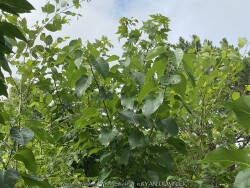

***Tree descriptions available with future update!***White Shield Fruitless-Thornless Osage Orange, is also known as Maclura pomifera 'White Shield'


Jane Magenta Flowering Magnolia (Magnolia 'Jane'), noted for its compact, upright habit, grows best in organically rich, medium-moisture soil that's neutral to slightly acidic. Reddish purple flowers with white interiors open later in spring to avoid frost damage. Flowers do seem to tolerate light freezes down to 28 degrees that have occured here at our Lawrence, KS display garden without damage. Flowers are a gorgeous tulip shape with a lightly scented fragrance. Leaves are medium to dark green turning a beautiful gold in the fall. Jane magnolia makes a great understory small tree, specimen plant, or background shrub slowly growing 10'-15' high. Grows best in full morning sun and partially shaded afternoons in hot climates. Avoid hot West or South exposures and winds. Magnolias in general are a family of plants that have been around for millions of years and are among the most primitive of all flowers. In fact, most magnolia flowers evolved before bees and are thus pollinated by beetles. Magnolias generally grow in moist, well drained soils in sun or shade. They have no serious pests or disease problems. Occasionally seen listed as Magnolia liliflora 'Reflorescens' x stellate 'Waterlily'
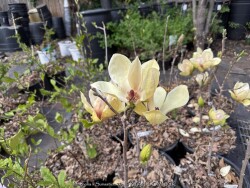

***Tree descriptions available with future update!*** Magnolia 'Sunsation' is also known as Sunsation Yellow Flowering Magnolia


Magnolia grandiflora 'Bracken's Brown Beauty' is one of the most cold hardy of the Southern Magnolias. Magnolias in general are a family of plants that have been around for millions of years and are among the most primitive of all flowers. In fact, most magnolia flowers evolved before bees and are thus pollinated by beetles. Magnolias generally have no serious pests or diseases. Any of the dwarf Southern Magnolia cultivars serve as a beautiful four seasons small tree or large shrub. Evergreen foliage is a shiny dark green with a brown-orange back that first emerges lighter green. If temperature stay above -10°F, foliage generally stays intact. If colder than that, it will shed its leaves like a deciduous tree when new growth occurs in April. Large tropical-looking white scented flowers bloom in late May and early June. Green cones, yes cones, follow in late summer with the cones opening up to yield beautiful red seeds. Seeds are viable but will not survive the winter here. Bracken's Brown Beauty Magnolias appreciate rich well-drained soil but will tolerate less than ideal clay soils. Sandy or rocky soils are tolerated if watering is sufficient. Magnolias can tolerate short periods of poor drainage but not consistent bog like conditions. Full sun is best but WELL-CARED for Magnolias can tolerate mostly shade in rich soils. This means do not use Magnolias under walnut trees, in dry shade, or exposed to north winds on the north side of a house. Being one of the few broadleaf evergreens hardy in zone 6, Bracken's Brown Beauty has many landscape uses. Several trees planted in a row or group will make an awesome wind and visual screen without the pest problems of coniferous evergreens. If ice or snow damage occurs, Magnolias have the ability to grow back reasonably quickly as opposed to most coniferous evergreens. In fact, Magnolias will come back from the ground is completely cut down and new growth from water sprouts will be rapid. Magnolias also make a great specimen tree or background for flowers and shrubs. Magnolias can be planted near a house without worrying about damaging root systems; they are very easily pruneable if they start getting too big. This highly-rated small landscape tree is perfect somewhere on your property!
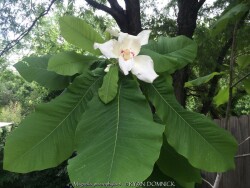

Bigleaf Magnolia (Magnolia macrophylla) features very large light green leaves that are the biggest simple leaf in North America measuring upto 36" long! They are native to pockets of the Appalachian mountains with perfect rich soils and protected from winds. One would think that plant like this would not do well in Kansas landscapes. However if given a little bit of wind protection, some watering, and decent soil, these trees will do fine and grow vigorously growing in sun or shade. Big leaf magnolias also produce large creamy white flowers and have silvery backs to their leaves adding to the appeal. With ideal conditions, a growth rate of 1 to 2 feet per year is possible. With more difficult conditions they will grow a few inches per year but still look attractive. There seems to be no other plant that can add a tropical feel like big leaf Magnolia. Magnolias in general are a family of plants that have been around for millions of years and are among the most primitive of all flowers. In fact, most magnolia flowers evolved before bees and are thus pollinated by beetles. Magnolias generally have no serious pests or diseases.


***Description for this plant available with future update!*** Magnolia x 'Felix' is also known as Felix Magnolia / Magenta-Pink Flowering Magnolia.


***Description for this plant available with future update!*** Magnolia x 'Genie' is also known as Genie Magnolia / Magenta Flowering Magnolia.


***Description for this plant available with future update!*** Magnolia x 'Vulcan' is also known as Vulcan Magnolia / Red-Magenta Flowering Magnolia.
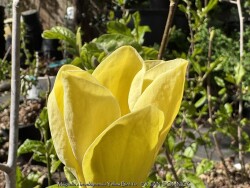

Yellow Flowering Magnolia (Magnolia x brooklynensis 'Yellow Bird') is a rare jewel in the landscape: a tree with giant canary yellow flowers! Yellow Bird is an upright, conical to pyramidal, large deciduous tree that can grow 40 feet tall in Kansas. This magnolia would be a fine residential specimen in sheltered locations with moist, rich soil with plenty of space to spread. Magnolias in general are a family of plants that have been around for millions of years and are among the most primitive of all flowers. In fact, most magnolia flowers evolved before bees and are thus pollinated by beetles. Magnolias generally grow in moist, well drained soils in sun or shade. They have no serious pests or disease problems.
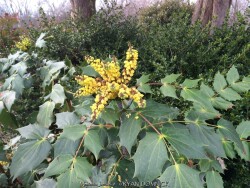

Leatherleaf Mahonia (Mahonia bealei) is a slow-growing coarse-textured evergreen shrub with bright green holly-like leaflets. The leaves are prickly and make a fine barrier or specimen plant. Native to continental climates in China, Mahonia bealei can be invasive in Eastern US woods where its shade tolerance and slow evergreen growth eventually shade out native plants. This is not a problem in Kansas due to extreme winters and dryer conditions. Flowering tries to occur in mid to late winter in Kansas but are usually frozen before they can open. During a "once in 5 years" mild winter if temperatures stay above 0 degrees F, fragrant, lemon-yellow flowers do develop. Even more rare is to have a long enough warm spell in winter to allow the beautiful blackish-blue fruit to develop afterward. If they do, they will be enjoyed by birds but any small seedlings that do germinate are killed by ground freezes the next winter. Leatherleaf Mahonia is very drought tolerant when established making it an ideal dry-shade plant; the 40 inches of typical rainfall in Eastern Kansas is sufficient if planted in rototilled soils. This could be one of the most cold-tolerant broadleaf evergreens available! It survived -16 degrees F and a week of single digit highs in February, 2021 with no damage. It even maintains bright green foliage in winter opposed to a dingy brownish-green like some evergreens. In Eastern Kansas, this species performs WELL with just about everything nature has to challenge it! Heat and drought are tolerated if in shade or morning sun. Cold tolerance is no problem. Invasiveness is not a problem. No disease or pest problems. And again, this is a great evergreen plant for difficult dry-shade situations under mature trees where lawn won't grow.


Leatherleaf Mahonia (Mahonia x media 'Marvel') is a slow-growing coarse-textured evergreen shrub with bright green holly-like leaflets. The leaves are prickly and make a fine barrier or specimen plant. Native to continental climates in China, Mahonia bealei can be invasive in Eastern US woods where its shade tolerance and slow evergreen growth eventually shade out native plants. This is not a problem in Kansas due to extreme winters and dryer conditions. Flowering tries to occur in mid to late winter in Kansas but are usually frozen before they can open. During a "once in 5 years" mild winter if temperatures stay above 0 degrees F, fragrant, lemon-yellow flowers do develop. Even more rare is to have a long enough warm spell in winter to allow the beautiful blackish-blue fruit to develop afterward. If they do, they will be enjoyed by birds but any small seedlings that do germinate are killed by ground freezes the next winter. Leatherleaf Mahonia is very drought tolerant when established making it an ideal dry-shade plant; the 40 inches of typical rainfall in Eastern Kansas is sufficient if planted in rototilled soils. This could be one of the more cold-tolerant broadleaf evergreens available! 'Marvel' survived -16 degrees F and a week of single digit highs in February, 2021 but with complete foliage loss. It even maintains bright green foliage in winter opposed to a dingy brownish-green like some evergreens. In Eastern Kansas, this species performs WELL with just about everything nature has to challenge it! Heat and drought are tolerated if in shade or morning sun. Cold tolerance is no problem. Invasiveness is not a problem. No disease or pest problems. And again, this is a great evergreen plant for difficult dry-shade situations under mature trees where lawn won't grow. Mahonia x media 'Marvel' is an improved cultivar that is more compact than other varieties. Evergreen foliage is a medium glossy green and more fine-textures compared to the species. Frond-like leaves develop in whorls and are arranged along coarsely branched stems creating an architectural effect. It is unknown at this point (2022) if flowers and fruit will develop here in Kansas zone 6a but it is doubtful seeing how it tries to bloom in the winter similar to the species.


***Description for this hardy tropical available with future update!***Red Turk's Cap, is also known as Malvaviscus arboreus var. drummondii
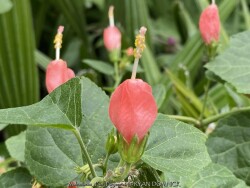

***Description for this hardy tropical available with future update!***Pink Turk's Cap, is also known as Malvaviscus drummondii 'Pam Puryear'
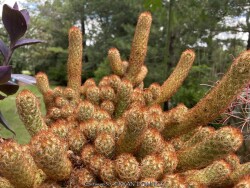

***Description for this plant available with future update!*** Mammillaria elongata ‘Copper King’ is also known as Copper King Lady Finger Cactus (Tropical)>>>>> Cacti are known for their spines, unusual shapes and beautiful flowers. Both succulents and cacti store water in their fleshy tissues. And can survive long periods without water. Cacti and succulents are usually grown as a deck/patio plant or house plant in Kansas. Grow in full sun with little to no extra watering except that which comes from rainfall. Generally, plants may be brought out in Late May through Early October in our zone 6a Lawrence, KS climate. To play is safe, potted plants are best moved in before autumn leaves begin to drop and before night temperatures get below 45 degrees F. It is very important to avoid the combination of wet and cold. Move to a bright interior window over the winter with little to no watering and keep above 50 degrees F. As a winter house plant, it will look presentable all winter long with little to no waterings. As a permanent house plant, provide bright light and allow the soil to dry completely between waterings and you will get many years of carefree enjoyment. Plants grown permanently indoors may eventually begin to elongate stretching for light and lose their spine color. It can be hard to reproduce the intense UV sunlight they need when growing indoors so moving outside for the summer is best. Generally if moving outside for the summer, allow 1-2 weeks of part shade or morning sun before placing in full sun. Plants with time to acclimate will thrive in full sun but be careful not to rush it or sunburning may occur. Repotting may or may not be needed depending on how large you want the plant to grow; plants can continue to grow taller and tolerate extremely root-bound pots but may need wind bracing. If repotting, make sure to use a sharp draining low organic cactus mix with plenty of sand and perlite but avoid peat moss. The “soil” most commercial cacti are potted in to too peaty and light weight. This soil becomes hydrophobic and shrinks after becoming bone dry and difficult to re wet again. Cacti never grow in peat-based soils in nature; this “Soil” is only good for shipping because of the light weight. Potted plants are very low maintenance but watch for scale and mealybugs that may hide beneath the cover of spines. The best pest removal approach is to periodically wash the cactus off. Achieve this with a water nozzle or hose breaker turned mostly off to increase the pressure from the blast of water. This high-pressured water kills the pests without damaging the thick cactus skin. Here are some little-known or rare factoids about cacti: 1. The "spines" are actually modified leaves filled with sap at first, then quickly drying out to form the spines! 2. Many cacti have bright colored flowers that mainly attract bees, while some tubular flowering types attract hummingbirds and bats. 3. Late on the evolutionary timeline, cacti fossils are rare to non-existent. Cacti are native almost exclusively to the Americas, while succulents can include a much larger plant palette be from any dry area in the world. 4. Some cactus plants have been known to survive more than 2 years without water. 5. Some cacti first evolved in a dry climate that later became wetter again. For example: several jungle species live as epiphytes in trees to achieve the fast drainage they need.


***Description for this plant available with future update!*** Mammillaria gracilis fragilis is also known as Thimble Cactus (Tropical)>>>>> Cacti are known for their spines, unusual shapes and beautiful flowers. Both succulents and cacti store water in their fleshy tissues. And can survive long periods without water. Cacti and succulents are usually grown as a deck/patio plant or house plant in Kansas. Grow in full sun with little to no extra watering except that which comes from rainfall. Generally, plants may be brought out in Late May through Early October in our zone 6a Lawrence, KS climate. To play is safe, potted plants are best moved in before autumn leaves begin to drop and before night temperatures get below 45 degrees F. It is very important to avoid the combination of wet and cold. Move to a bright interior window over the winter with little to no watering and keep above 50 degrees F. As a winter house plant, it will look presentable all winter long with little to no waterings. As a permanent house plant, provide bright light and allow the soil to dry completely between waterings and you will get many years of carefree enjoyment. Plants grown permanently indoors may eventually begin to elongate stretching for light and lose their spine color. It can be hard to reproduce the intense UV sunlight they need when growing indoors so moving outside for the summer is best. Generally if moving outside for the summer, allow 1-2 weeks of part shade or morning sun before placing in full sun. Plants with time to acclimate will thrive in full sun but be careful not to rush it or sunburning may occur. Repotting may or may not be needed depending on how large you want the plant to grow; plants can continue to grow taller and tolerate extremely root-bound pots but may need wind bracing. If repotting, make sure to use a sharp draining low organic cactus mix with plenty of sand and perlite but avoid peat moss. The “soil” most commercial cacti are potted in to too peaty and light weight. This soil becomes hydrophobic and shrinks after becoming bone dry and difficult to re wet again. Cacti never grow in peat-based soils in nature; this “Soil” is only good for shipping because of the light weight. Potted plants are very low maintenance but watch for scale and mealybugs that may hide beneath the cover of spines. The best pest removal approach is to periodically wash the cactus off. Achieve this with a water nozzle or hose breaker turned mostly off to increase the pressure from the blast of water. This high-pressured water kills the pests without damaging the thick cactus skin. Here are some little-known or rare factoids about cacti: 1. The "spines" are actually modified leaves filled with sap at first, then quickly drying out to form the spines! 2. Many cacti have bright colored flowers that mainly attract bees, while some tubular flowering types attract hummingbirds and bats. 3. Late on the evolutionary timeline, cacti fossils are rare to non-existent. Cacti are native almost exclusively to the Americas, while succulents can include a much larger plant palette be from any dry area in the world. 4. Some cactus plants have been known to survive more than 2 years without water. 5. Some cacti first evolved in a dry climate that later became wetter again. For example: several jungle species live as epiphytes in trees to achieve the fast drainage they need.
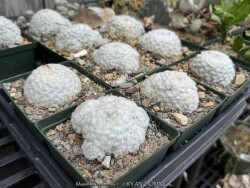

***Description for this plant available with future update!*** Mammillaria plumosa is also known as Feather Cactus (Tropical)>>>>> Cacti are known for their spines, unusual shapes and beautiful flowers. Both succulents and cacti store water in their fleshy tissues. And can survive long periods without water. Cacti and succulents are usually grown as a deck/patio plant or house plant in Kansas. Grow in full sun with little to no extra watering except that which comes from rainfall. Generally, plants may be brought out in Late May through Early October in our zone 6a Lawrence, KS climate. To play is safe, potted plants are best moved in before autumn leaves begin to drop and before night temperatures get below 45 degrees F. It is very important to avoid the combination of wet and cold. Move to a bright interior window over the winter with little to no watering and keep above 50 degrees F. As a winter house plant, it will look presentable all winter long with little to no waterings. As a permanent house plant, provide bright light and allow the soil to dry completely between waterings and you will get many years of carefree enjoyment. Plants grown permanently indoors may eventually begin to elongate stretching for light and lose their spine color. It can be hard to reproduce the intense UV sunlight they need when growing indoors so moving outside for the summer is best. Generally if moving outside for the summer, allow 1-2 weeks of part shade or morning sun before placing in full sun. Plants with time to acclimate will thrive in full sun but be careful not to rush it or sunburning may occur. Repotting may or may not be needed depending on how large you want the plant to grow; plants can continue to grow taller and tolerate extremely root-bound pots but may need wind bracing. If repotting, make sure to use a sharp draining low organic cactus mix with plenty of sand and perlite but avoid peat moss. The “soil” most commercial cacti are potted in to too peaty and light weight. This soil becomes hydrophobic and shrinks after becoming bone dry and difficult to re wet again. Cacti never grow in peat-based soils in nature; this “Soil” is only good for shipping because of the light weight. Potted plants are very low maintenance but watch for scale and mealybugs that may hide beneath the cover of spines. The best pest removal approach is to periodically wash the cactus off. Achieve this with a water nozzle or hose breaker turned mostly off to increase the pressure from the blast of water. This high-pressured water kills the pests without damaging the thick cactus skin. Here are some little-known or rare factoids about cacti: 1. The "spines" are actually modified leaves filled with sap at first, then quickly drying out to form the spines! 2. Many cacti have bright colored flowers that mainly attract bees, while some tubular flowering types attract hummingbirds and bats. 3. Late on the evolutionary timeline, cacti fossils are rare to non-existent. Cacti are native almost exclusively to the Americas, while succulents can include a much larger plant palette be from any dry area in the world. 4. Some cactus plants have been known to survive more than 2 years without water. 5. Some cacti first evolved in a dry climate that later became wetter again. For example: several jungle species live as epiphytes in trees to achieve the fast drainage they need.


***Description for this plant available with future update!*** Mammillaria prolifera is also known as Texas nipple cactus (Tropical)>>>>> Cacti are known for their spines, unusual shapes and beautiful flowers. Both succulents and cacti store water in their fleshy tissues. And can survive long periods without water. Cacti and succulents are usually grown as a deck/patio plant or house plant in Kansas. Grow in full sun with little to no extra watering except that which comes from rainfall. Generally, plants may be brought out in Late May through Early October in our zone 6a Lawrence, KS climate. To play is safe, potted plants are best moved in before autumn leaves begin to drop and before night temperatures get below 45 degrees F. It is very important to avoid the combination of wet and cold. Move to a bright interior window over the winter with little to no watering and keep above 50 degrees F. As a winter house plant, it will look presentable all winter long with little to no waterings. As a permanent house plant, provide bright light and allow the soil to dry completely between waterings and you will get many years of carefree enjoyment. Plants grown permanently indoors may eventually begin to elongate stretching for light and lose their spine color. It can be hard to reproduce the intense UV sunlight they need when growing indoors so moving outside for the summer is best. Generally if moving outside for the summer, allow 1-2 weeks of part shade or morning sun before placing in full sun. Plants with time to acclimate will thrive in full sun but be careful not to rush it or sunburning may occur. Repotting may or may not be needed depending on how large you want the plant to grow; plants can continue to grow taller and tolerate extremely root-bound pots but may need wind bracing. If repotting, make sure to use a sharp draining low organic cactus mix with plenty of sand and perlite but avoid peat moss. The “soil” most commercial cacti are potted in to too peaty and light weight. This soil becomes hydrophobic and shrinks after becoming bone dry and difficult to re wet again. Cacti never grow in peat-based soils in nature; this “Soil” is only good for shipping because of the light weight. Potted plants are very low maintenance but watch for scale and mealybugs that may hide beneath the cover of spines. The best pest removal approach is to periodically wash the cactus off. Achieve this with a water nozzle or hose breaker turned mostly off to increase the pressure from the blast of water. This high-pressured water kills the pests without damaging the thick cactus skin. Here are some little-known or rare factoids about cacti: 1. The "spines" are actually modified leaves filled with sap at first, then quickly drying out to form the spines! 2. Many cacti have bright colored flowers that mainly attract bees, while some tubular flowering types attract hummingbirds and bats. 3. Late on the evolutionary timeline, cacti fossils are rare to non-existent. Cacti are native almost exclusively to the Americas, while succulents can include a much larger plant palette be from any dry area in the world. 4. Some cactus plants have been known to survive more than 2 years without water. 5. Some cacti first evolved in a dry climate that later became wetter again. For example: several jungle species live as epiphytes in trees to achieve the fast drainage they need.


***Description for this plant available with future update!*** Manettia cordifolia is also known as Red Firecracker Vine.
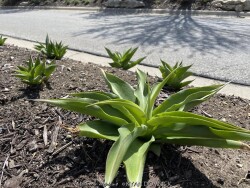

Hardy Manfreda (Manfreda virginica) are cute succulent perennials resembling a dwarf agave. The attractive green leaves are thick and fleshy with maroon spots extending to a point with a soft tip. Unusual, greenish-white, tubular flowers with conspicuous stamens are borne in a spike-like cluster atop 3-4' tall stalks. Some people prefer to trim the flowers for a more neat, compact look. Manfreda plants (also called American aloe) are native to eastern woods of Missouri, Oklahoma, Texas, Arkansas and much of the Southeast United States. This cold hardy succulent occupies an unusual niche: growing in poor shallow sandstone based soils in open woods and on sunny rock cliffs that dry out too quickly for most other plants to colonize. A good question is how does it find such isolated areas to colonize in the first place? Seeds are produced but do not spread far. Grow this small native gem in rock gardens, dry shade areas, in parking lot medians, in cracks between rocks, or on top of or in a retaining wall. It will re-seed to thicken the colony but only germinate in bare thin soils with no mulch. It will not tolerate competition in rich moist soils as other plants (or weeds) will shade it out. Most rock garden plants do not thrive indoors; aphids and spider mites seem to find them after a few months but overwintering indoors in a cool environment may work. If grown in pots and kept on the dry side, you may leave out all winter allowing to freeze solid; plants will go completely dormant and resume growth in the spring. Great low maintenance cold hardy succulent.
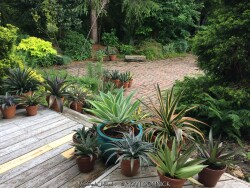

The variety of foliage colors and patterns make Mangave excellent architectural specimen plants. Mangave is a relatively new phenomenon, as a cross between the genus Manfreda and Agave. These rare hybrids combine the best of both worlds: the better growth rate and the interesting patterns of Manfreda, and the habit and refinement of Agave. Usually used as a patio or house plant in Kansas, they can also be grown as an annual. Grow in full sun to part sun with optional extra watering including that which comes from rainfall. Plants with time to acclimate will thrive in full sun but be careful not to rush it or sunburning will occur. Generally if moving outside for the summer, allow 2-3 weeks of part shade or morning sun before placing in full sun. Repotting may or may not be needed depending on how large you want the plant to grow; plants can continue to grow and tolerate extremely root-bound pots. Protect from temperatures below 35 degrees F and move into a bright window over the winter with no watering. Do not allow Mangave in pots to freeze solid or get close to freezing especially if soil is wet or death may occur. As a winter house plant, it will look presentable all winter long with just a few monthly or no waterings if you forget. As a permanent house plant, provide bright light and allow the soil to dry between waterings for many years of carefree enjoyment. Potted plants are very low maintenance needing only old leaves trimmed once per year. This is not at all a big-box store plant so be prepared to expand your plant palette with Mangave!
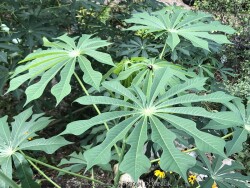

Hardy Tapioca (Manihot grahamii) is typically grown in warmer zones as a shrub or tree in the family Euphorbiaceae native to South America. Along with other tropicals and succulents in Kansas, hardy tapioca is usually grown as summer patio plant with amazing artistically whorled green leaves and small yellow flowers loved by bees. Water regularly and place in full sun or part shade. Protect from temperatures below 20 degrees F and move into a cold garage or basement over the winter with minimal watering. Do not allow the pot with rootball to freeze solid or go below 15 degrees for more than a few hours. Allow to go dormant as needed with little care, just cut off dead foliage/twigs and place back out in April or May with a time-release fertilizer. You may also propagate this plant easily by cutting off dormant twigs/branches and stuffing them into the ground. Notice that I didnt say rooting hormone or even being carefull was necessary! Landscapers also plant these as an annual in the ground for an enormous tropical effect with growth reaching 5-8' in one season from a 1gal container! It is possible to overwinter Manihot grahamii in the ground in Kansas as a woody perennial. In our trial gardens in Lawrence, KS (zone 6a), a one year established specimen planted on the South side of a house protected from winter moisture and mulched 12" thick with leaf mulch survived -17 degrees F. During the arctic blast of February, 2021, lows down to -17 degrees F on Feb 16th, 2021 were recorded. The longevity of this cold blast was also impressive: 10 days on a row with highs of 10-15 degrees F or lower, 8 nights of lows in the single digits and negatives, and 36 strait hours of 0 degrees F and mostly lower.
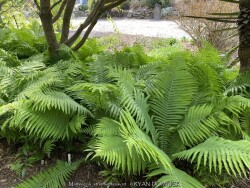

Ostrich Fern (Matteuccia struthiopteris) is planted for its graceful long bright green fronds reaching up to 3' in cultivation. Foliage maintains well all summer provided that certain cultural conditions are met. Native to eastern North America, Europe, eastern Asia, eastern North America, it colonizes forests and can be aggressive in ideal locations but not so much in Kansas. It can spread rapidly in humusy, medium well-drained soil in part shade to full shade. It cannot handle prolonged Kansas droughts or dry-shade. Foliage will flatten to the ground during breif drought then spring back up when moisture is available again. Generally however, in non-irrigated or poor soil areas, this plant will decline and allow weeds to invade. Perfect in wet shade areas, north walls, areas without tree-root competition, or shaded rain gardens. Ultra cold-hardy plants from northern climates normally dislike our long hot humid summers; although we are on the Southern edge of this plants adaptability, it still survives reasonably well here. Look for a cold microclimate planting location such as East or North exposure.
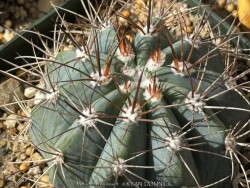

***Description for this plant available with future update!*** Melocactus azureus is also known as Blue Turk's Cap Cactus (Tropical)>>>>> Cacti are known for their spines, unusual shapes and beautiful flowers. Both succulents and cacti store water in their fleshy tissues. And can survive long periods without water. Cacti and succulents are usually grown as a deck/patio plant or house plant in Kansas. Grow in full sun with little to no extra watering except that which comes from rainfall. Generally, plants may be brought out in Late May through Early October in our zone 6a Lawrence, KS climate. To play is safe, potted plants are best moved in before autumn leaves begin to drop and before night temperatures get below 45 degrees F. It is very important to avoid the combination of wet and cold. Move to a bright interior window over the winter with little to no watering and keep above 50 degrees F. As a winter house plant, it will look presentable all winter long with little to no waterings. As a permanent house plant, provide bright light and allow the soil to dry completely between waterings and you will get many years of carefree enjoyment. Plants grown permanently indoors may eventually begin to elongate stretching for light and lose their spine color. It can be hard to reproduce the intense UV sunlight they need when growing indoors so moving outside for the summer is best. Generally if moving outside for the summer, allow 1-2 weeks of part shade or morning sun before placing in full sun. Plants with time to acclimate will thrive in full sun but be careful not to rush it or sunburning may occur. Repotting may or may not be needed depending on how large you want the plant to grow; plants can continue to grow taller and tolerate extremely root-bound pots but may need wind bracing. If repotting, make sure to use a sharp draining low organic cactus mix with plenty of sand and perlite but avoid peat moss. The “soil” most commercial cacti are potted in to too peaty and light weight. This soil becomes hydrophobic and shrinks after becoming bone dry and difficult to re wet again. Cacti never grow in peat-based soils in nature; this “Soil” is only good for shipping because of the light weight. Potted plants are very low maintenance but watch for scale and mealybugs that may hide beneath the cover of spines. The best pest removal approach is to periodically wash the cactus off. Achieve this with a water nozzle or hose breaker turned mostly off to increase the pressure from the blast of water. This high-pressured water kills the pests without damaging the thick cactus skin. Here are some little-known or rare factoids about cacti: 1. The "spines" are actually modified leaves filled with sap at first, then quickly drying out to form the spines! 2. Many cacti have bright colored flowers that mainly attract bees, while some tubular flowering types attract hummingbirds and bats. 3. Late on the evolutionary timeline, cacti fossils are rare to non-existent. Cacti are native almost exclusively to the Americas, while succulents can include a much larger plant palette be from any dry area in the world. 4. Some cactus plants have been known to survive more than 2 years without water. 5. Some cacti first evolved in a dry climate that later became wetter again. For example: several jungle species live as epiphytes in trees to achieve the fast drainage they need.
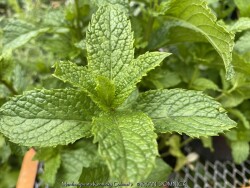

***Description for this perennial available with future update!*** Mentha spicata 'Kentucky Colonel' is also known as Kentucky Colonel Improved Mint >>>>>This plant can also be used as a marginal aquatic plant growing in shallow water. It can also grow as a bog plant needing constantly moist soil rich in organic matter. As a rain garden plant, it will thrive is a depressed area in the landscape that collects rain water from a roof during spring and summer periods of rain but then go dormant if the water hole dries out completely.>>>>>For the home garden, the species is generally too aggressive to mix with other plants>>>>>>>>>Also known as "Kentucky Colonel" mint, this hybrid of applemint (Mentha suaveolens) and true spearmint (M. spicata) has a wonderful fruity spearmint aroma and flavour. >>>>>>>>>>>>>>>>>>>>Its improved disease resistance and high yields make it a popular choice for commercial cultivation. >>>>>>>>>>>>>>>>The vigorous tendencies of mints allow them to be cut more frequently than most other herbs, growing back to a useful stage rapidly. For the home grower they are perfect for cultivation in large pots, where their tendency to march out of the garden and into the lawn can be restrained.


***Tree descriptions available with future update!***Dawn Redwood, is also known as Metasequoia glyptostroboides
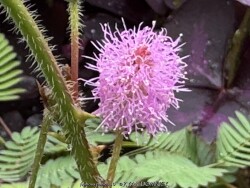

***Description for this plant available with future update!*** Mimosa pudica is also known as Sensitive Plant Mimosa (Tropical).


Wild Perennial Four O'Clock (Mirabilis multiflora) is a beautiful mound-forming native wildflower found from Texas, New Mexico, Colorado, and West to California. Flowers, born over a long period, are bright pink with a magenta center. Foliage is an attractive mint green to grey-green with hints of pink on new growth. This tap-rooted herbaceous perennial can grow up to 2 feet tall and 6 feet across but completely dies back in the fall and does not root as it spreads. A mature plant can have hundreds of flowers blooming at the same time! Flowers last only 1 day but more will follow tthe next day. Self-seeding is rare in our Kansas display garden. Typical landscape uses in Kansas are as follows: annual plantings, parking lot islands, hot West and South exposures, south facing berms, and xeriscape gardens. It will thrive in most soils but not poor drainage. Having desert heritage, it resents poor drainage and winter moisture. To counteract that in Kansas, plant in full sun on berm or south-facing wall with poor sandy or rocky soil with no irrigation. It would be very useful as a vine-like perennial cascading over the top of a retaining wall! Amazing that a perennial native to areas receiving 4-10" of rain per year can grow in a climate receiving 4-10 times more rain!
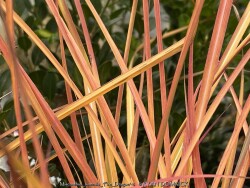

***Description for this grass available with future update!***Fire Dragon Red Maiden Grass, is also known as Miscanthus sinensis 'Fire Dragon'
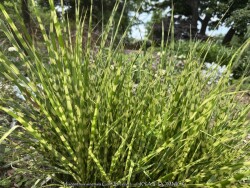

***Description for this grass available with future update!***Green&Gold Banded Maiden Grass, is also known as Miscanthus sinensis 'Gold Breeze'
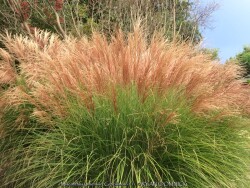

***Description for this grass available with future update!***Gracillimus Green Maiden Grass, is also known as Miscanthus sinensis 'Gracillimus'
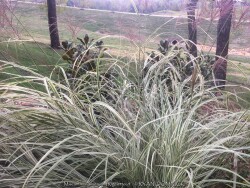

***Description for this grass available with future update!***Rigeletto Variegated Maiden Grass, is also known as Miscanthus sinensis 'Rigeletto'
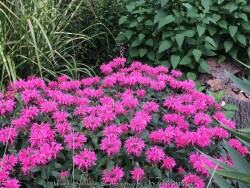

***Description for this perennial available with future update!***Bubblegum Blast Sugar Buzz Bee balm, is also known as Monarda 'Bubblegum Blast' Sugar Buzz
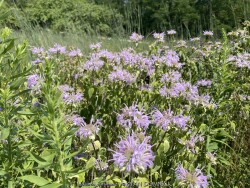

***Description for this perennial available with future update!***Eastern Beebalm / Monarda, is also known as Monarda bradburiana. >>>>> Monarda bradburiana is often considered a superior beebalm for the garden. Attributes include its mildew resistance, short stocky stature, earlier bloom time and less aggressive spreading than other Monardas. Monarda fistulosa has similar appearance and culture and could be substituted in some situations if a longer blooming time is desired but with higher incidence of powdery mildew if air circulation is poor.
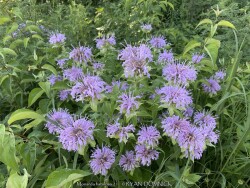

***Description for this perennial available with future update!***Native Beebalm / Wild Bergamot, is also known as Monarda fistulosa ***Description for this plant available with future update!***
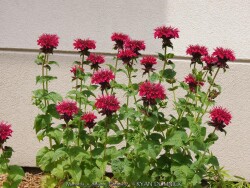

***Description for this perennial available with future update!***Fireball Dwarf Beebalm / Monarda, is also known as Monarda x didyma 'Fireball'
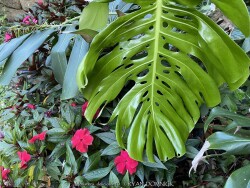

Split Leaf Philodendron / Swiss Cheese Plant (Monstera deliciosa) is a large tropical plant. This member of the arum family Araceae is an epiphyte with aerial roots, able to grow up to 66 ft high in the wild, with large, leathery, glossy, pinnate, heart-shaped leaves 12-36" ft long by 12-30" broad. The leaves on young plants are smaller and entire with no lobes or holes, but soon produce lobed and fenestrate leaves as they grow. Although it can grow very tall in nature, it only measures between 6-10 ft) when grown indoors. The older the plant, the more the leaves are covered with its familiar large perforations. This plant lives in the humid tropical forests, in the lowlands and middle mountains, in the extreme south of Mexico, Central America, and south tip of Florida. The seeds fall to the ground, then the seedlings grow towards the dark (negative phototropism) until they meet a tree on which to attach. The many adjacent roots thus allow the plant to anchor against its new support and reach the canopy light (although it rarely grows in full sun and prefers a light dimmed by the foliage). Monstera deliciosa is commonly grown outdoors as an ornamental plant in the tropics and subtropics. The plant requires a lot of space and a rich and loose soil (ideally garden soil and compost in equal parts). If it grows in the ground it is better to plant it near a tree, where it can climb, if not against a trellis. It is moderately greedy and needs to be watered just to keep the soil slightly moist. Hardy to zone 11, it cannot withstand freezing temperatures for more than a few hours. A steady minimum temperature of at least 55-59°F is preferable, allowing continuous growth. Growth ceases below 50°F but tolerant down to 32°F if kept on the dry side. Its architectural qualities, ease of cultivation, and tolerance of a wide range of conditions make it an ideal plant for indoor cultivation as well. For this reason it is a popular plant for the home or office throughout the temperate northern hemisphere. It prefers bright indirect light and temperatures of 68-86°F. Flowering is rare when grown indoors. Along with other tropicals and succulents in Kansas, Split Leaf Philodendron / Swiss Cheese Plant is usually grown as large summer patio plant. Water regularly and place in full shade or very limited morning sun possibly in a large ceramic pot under an established shade thee for the summer. They handle the transition moving in and out rather well and hold up nicely during winter if you have dark, cold, or un-ideal conditions provided that they get a good growing season outdoors for 1/2 the year.


Thai Constellation' Split Leaf Philodendron / Swiss Cheese Plant (Monstera deliciosa) is a large tropical plant. This member of the arum family Araceae is an epiphyte with aerial roots, able to grow up to 66 ft high in the wild, with large, leathery, glossy, pinnate, heart-shaped leaves 12-36" ft long by 12-30" broad. The leaves on young plants are smaller and entire with no lobes or holes, but soon produce lobed and fenestrate leaves as they grow. Although it can grow very tall in nature, it only measures between 6-10 ft) when grown indoors. The older the plant, the more the leaves are covered with its familiar large perforations. This plant lives in the humid tropical forests, in the lowlands and middle mountains, in the extreme south of Mexico, Central America, and south tip of Florida. The seeds fall to the ground, then the seedlings grow towards the dark (negative phototropism) until they meet a tree on which to attach. The many adjacent roots thus allow the plant to anchor against its new support and reach the canopy light (although it rarely grows in full sun and prefers a light dimmed by the foliage). Monstera deliciosa is commonly grown outdoors as an ornamental plant in the tropics and subtropics. The plant requires a lot of space and a rich and loose soil (ideally garden soil and compost in equal parts). If it grows in the ground it is better to plant it near a tree, where it can climb, if not against a trellis. It is moderately greedy and needs to be watered just to keep the soil slightly moist. Hardy to zone 11, it cannot withstand freezing temperatures for more than a few hours. A steady minimum temperature of at least 55-59°F is preferable, allowing continuous growth. Growth ceases below 50°F but tolerant down to 32°F if kept on the dry side. Its architectural qualities, ease of cultivation, and tolerance of a wide range of conditions make it an ideal plant for indoor cultivation as well. For this reason it is a popular plant for the home or office throughout the temperate northern hemisphere. It prefers bright indirect light and temperatures of 68-86°F. Flowering is rare when grown indoors. Along with other tropicals and succulents in Kansas, 'Thai Constellation' Split Leaf Philodendron / Swiss Cheese Plant is usually grown as large summer patio plant. Water regularly and place in full shade or very limited morning sun possibly in a large ceramic pot under an established shade thee for the summer. They handle the transition moving in and out rather well and hold up nicely during winter if you have dark, cold, or un-ideal conditions provided that they get a good growing season outdoors for 1/2 the year.


***Shrub descriptions available with future update!***Morella cerifera, also known as Hardy Southern Wax Myrtle is a new evergreen addition to our Lawrence, KS zone 6 display garden. Very salt tolerant for areas near roads where salting is frequent in winter. ***Description for this plant available with future update!***


***Description for this grass available with future update!***Fast Forward Pink Muhly Grass, is also known as Muhlenbergia capillaris 'Fast Forward'
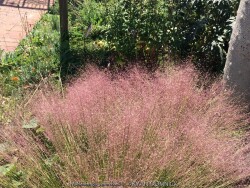

***Description for this grass available with future update!***Undaunted Ruby Muhly Grass, is also known as Muhlenbergia reverchonii


Create a tropical effect in your landscape with these large fast-growing cold hardy Musa basjoo! (also called Japanese fiber banana) Each leaf can be 6 feet long and 2 feet wide. Leave in ground and mulch 6" thick and they will return as perennials every year. If planting on the south side of a house in full sun, little protection is needed. These have proven hardy in Lawrence, KS (zone 6a) for over 20 years. In Eastern Kansas, typically our 40 inches of rainfall is sufficient without extra water in good soils. This species will tolerate some degree of drought but fastest growth will occur in rich well-drained soils with extra water and fertilizer provided during the summer. Great for summer wet areas in full sun or around swimming pools (creates no messes). Plants are capable of growing 15-18 feet by the end of summer when established and happy! A more realistic height is 7-12 feet under average conditions. Banana trees will slowly divide and send up offsets; this is a desirable sign that the banana tree is establishing well. If 1-2 feet of trunk is protected with a large pile of leaf mulch, you will get a flower followed by small inedible bananas the 2nd year on the largest trunk. The flowering trunk will die but the offsets will grow. Bananas will not tolerate excessively wet soils during dormancy. Sunburning can happen with summer temperatures over 100 degrees F but it will quickly outgrow the damage. Bananas need at least 1/2 day of full sun and protection from excessive winds to properly grow. Listed by many sources as hardy to zone 6 or 7, with proper mulching and placement near a foundation, you can easily grow this into zone 5 or possibly lower. In our trial gardens in Lawrence, KS (zone 6a), two well established specimens have thrived for 15 years and counting. During the arctic blast of February, 2021, lows down to -17 degrees F on Feb 16th, 2021 were recorded. The longevity of this cold blast was also impressive: 10 days on a row with highs of 10-15 degrees F or lower, 8 nights of lows in the single digits and negatives, and 36 straight hours of 0 degrees F and mostly lower. A hard ground freeze was inevitable; hundreds of plants around town survived this event returning a little late the following spring but otherwise just fine. Some were mulched with ground up leaf mulch, some were not.
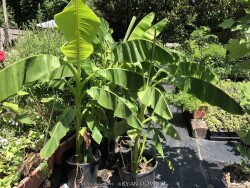

Create a tropical effect in your landscape with these large fast-growing cold hardy Musa basjoo! (also called Japanese fiber banana) Each leaf can be 6 feet long and 2 feet wide. Leave in ground and mulch 6" thick and they will return as perennials every year. If planting on the south side of a house in full sun, little protection is needed. These have proven hardy in Lawrence, KS (zone 6a) for over 20 years. In Eastern Kansas, typically our 40 inches of rainfall is sufficient without extra water in good soils. This species will tolerate some degree of drought but fastest growth will occur in rich well-drained soils with extra water and fertilizer provided during the summer. Great for summer wet areas in full sun or around swimming pools (creates no messes). Plants are capable of growing 15-18 feet by the end of summer when established and happy! A more realistic height is 7-12 feet under average conditions. Banana trees will slowly divide and send up offsets; this is a desirable sign that the banana tree is establishing well. If 1-2 feet of trunk is protected with a large pile of leaf mulch, you will get a flower followed by small inedible bananas the 2nd year on the largest trunk. The flowering trunk will die but the offsets will grow. Bananas will not tolerate excessively wet soils during dormancy. Sunburning can happen with summer temperatures over 100 degrees F but it will quickly outgrow the damage. Bananas need at least 1/2 day of full sun and protection from excessive winds to properly grow. Listed by many sources as hardy to zone 6 or 7, with proper mulching and placement near a foundation, you can easily grow this into zone 5 or possibly lower. In our trial gardens in Lawrence, KS (zone 6a), two well established specimens have thrived for 15 years and counting. During the arctic blast of February, 2021, lows down to -17 degrees F on Feb 16th, 2021 were recorded. The longevity of this cold blast was also impressive: 10 days on a row with highs of 10-15 degrees F or lower, 8 nights of lows in the single digits and negatives, and 36 straight hours of 0 degrees F and mostly lower. A hard ground freeze was inevitable; hundreds of plants around town survived this event returning a little late the following spring but otherwise just fine. Some were mulched with ground up leaf mulch, some were not.
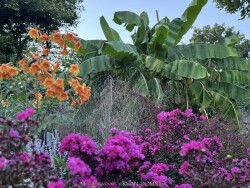

Create a tropical effect in your landscape with these large fast-growing cold hardy Musa basjoo! (also called Japanese fiber banana) Each leaf can be 6 feet long and 2 feet wide. Leave in ground and mulch 6" thick and they will return as perennials every year. If planting on the south side of a house in full sun, little protection is needed. These have proven hardy in Lawrence, KS (zone 6a) for over 20 years. In Eastern Kansas, typically our 40 inches of rainfall is sufficient without extra water in good soils. This species will tolerate some degree of drought but fastest growth will occur in rich well-drained soils with extra water and fertilizer provided during the summer. Great for summer wet areas in full sun or around swimming pools (creates no messes). Plants are capable of growing 15-18 feet by the end of summer when established and happy! A more realistic height is 7-12 feet under average conditions. Banana trees will slowly divide and send up offsets; this is a desirable sign that the banana tree is establishing well. If 1-2 feet of trunk is protected with a large pile of leaf mulch, you will get a flower followed by small inedible bananas the 2nd year on the largest trunk. The flowering trunk will die but the offsets will grow. Bananas will not tolerate excessively wet soils during dormancy. Sunburning can happen with summer temperatures over 100 degrees F but it will quickly outgrow the damage. Bananas need at least 1/2 day of full sun and protection from excessive winds to properly grow. Listed by many sources as hardy to zone 6 or 7, with proper mulching and placement near a foundation, you can easily grow this into zone 5 or possibly lower. In our trial gardens in Lawrence, KS (zone 6a), two well established specimens have thrived for 15 years and counting. During the arctic blast of February, 2021, lows down to -17 degrees F on Feb 16th, 2021 were recorded. The longevity of this cold blast was also impressive: 10 days on a row with highs of 10-15 degrees F or lower, 8 nights of lows in the single digits and negatives, and 36 straight hours of 0 degrees F and mostly lower. A hard ground freeze was inevitable; hundreds of plants around town survived this event returning a little late the following spring but otherwise just fine. Some were mulched with ground up leaf mulch, some were not.
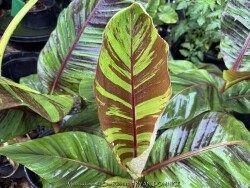

Create a tropical effect in your landscape with the worlds most cold red-leafed banana. Fast-growing and cold hardy, Red Hardy Banana Tree (Musa sikkimensis 'Ever Red') features reddish maroon striped randomly along the leaves in various widths to create a spectacular show! Leave in ground and mulch 6-9" thick and they will return as perennials every year. In Eastern Kansas, typically our 40 inches of rainfall is sufficient without extra water in good soils. This species will tolerate some degree of drought but fastest growth will occur in rich well-drained soils with extra water and fertilizer provided during the summer. Great for wet areas in full sun or around swimming pools (creates no messes). Plants are typically grow 5-8 feet by the end of summer and upto 15 feet in year two. Banana trees will slowly divide and send up offsets; this is a desirable sign that the banana tree is establishing well. The flowering trunk will die but many new offsets will take its place. Bananas will not tolerate excessively wet soils during dormancy. Sunburning can happen with summer temperatures over 100 degrees F but it will quickly outgrow the damage. Bananas need at least 1/2 day of full sun and protection from excessive winds to properly grow.


Create a tropical effect in your landscape with fast-growing cold hardy Pink Velvet Hardy Banana (Musa veluntina)! Leave in ground and mulch 6-9" thick and they will return as perennials every year. In Eastern Kansas, typically our 40 inches of rainfall is sufficient without extra water in good soils. This species will tolerate some degree of drought but fastest growth will occur in rich well-drained soils with extra water and fertilizer provided during the summer. Great for wet areas in full sun or around swimming pools (creates no messes). Plants are typically grow 5-8 feet by the end of summer and flower in only 6-8 months! Gorgeous pink and red flowers are followed by inedible pink fruits! Banana trees will slowly divide and send up offsets; this is a desirable sign that the banana tree is establishing well. The flowering trunk will die but many new offsets will take its place. Bananas will not tolerate excessively wet soils during dormancy. Sunburning can happen with summer temperatures over 100 degrees F but it will quickly outgrow the damage. Bananas need at least 1/2 day of full sun and protection from excessive winds to properly grow. Listed by many sources as hardy to zone 7, with proper mulching and placement near a foundation, you can easily grow this in zone 6. An large established grove exists at OSU Botanical Gardens in Stillwater, OK. This grove has proven hardy with no mulch (only frozen back top growth) and lows down to -14 degrees F on Feb 16th, 2021. The longevity of this cold blast was also impressive: 12 days on a row with highs below 32 degrees F, 7 nights of lows in the single digits and negatives and 48-60 hours of 5 degrees F and mostly lower. A hard ground freeze was inevitable with no rhizome or lower stem damage.
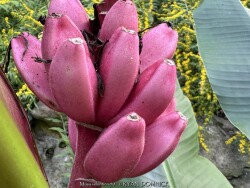

Create a tropical effect in your landscape with fast-growing cold hardy Pink Velvet Hardy Banana (Musa veluntina)! Leave in ground and mulch 6-9" thick and they will return as perennials every year. In Eastern Kansas, typically our 40 inches of rainfall is sufficient without extra water in good soils. This species will tolerate some degree of drought but fastest growth will occur in rich well-drained soils with extra water and fertilizer provided during the summer. Great for wet areas in full sun or around swimming pools (creates no messes). Plants are typically grow 5-8 feet by the end of summer and flower in only 6-8 months! Gorgeous pink and red flowers are followed by inedible pink fruits! Banana trees will slowly divide and send up offsets; this is a desirable sign that the banana tree is establishing well. The flowering trunk will die but many new offsets will take its place. Bananas will not tolerate excessively wet soils during dormancy. Sunburning can happen with summer temperatures over 100 degrees F but it will quickly outgrow the damage. Bananas need at least 1/2 day of full sun and protection from excessive winds to properly grow. Listed by many sources as hardy to zone 7, with proper mulching and placement near a foundation, you can easily grow this in zone 6. An large established grove exists at OSU Botanical Gardens in Stillwater, OK. This grove has proven hardy with no mulch (only frozen back top growth) and lows down to -14 degrees F on Feb 16th, 2021. The longevity of this cold blast was also impressive: 12 days on a row with highs below 32 degrees F, 7 nights of lows in the single digits and negatives and 48-60 hours of 5 degrees F and mostly lower. A hard ground freeze was inevitable with no rhizome or lower stem damage.


Create a tropical effect in your landscape with this large growing cold hardy Mekong Giant Banana (Musa xishuangbannaensis 'Mekong Giant')! Each leaf can be 6 feet long and 2 feet wide. Leave in ground and mulch 9-12" thick and they will return as perennials every year. In Eastern Kansas, typically our 40 inches of rainfall is sufficient without extra water in good soils. This species will tolerate some degree of drought but fastest growth will occur in rich well-drained soils with extra water and fertilizer provided during the summer. Great for summer wet areas in full sun or around swimming pools (creates no messes). Plants are capable of growing 25-40 feet in their natural habitat. A more realistic height of 7-12 feet is achieved in Eastern Kansas under average conditions. Banana trees will slowly divide and send up offsets; this is a desirable sign that the banana tree is establishing well. Mekong Giant will spread our with further traveling rhizomes than Musa basjoo; sometimes 3-5 feet away. Another strange observation with our display garden plant is that it survives each year but only from spreading rhizomes: the main trunks never make it through the winter even with lots of mulch. I suspect the main trunks are rotting but rhizomes survive just fine. Spring emergence is always later than basjoo, often waiting until June to emerge from the ground. This banana seems more sensitive to and will not tolerate excessively wet soils during dormancy. Sunburning can happen with summer temperatures over 100 degrees F but it will quickly outgrow the damage. Bananas need at least 1/2 day of full sun and protection from excessive winds to properly grow. In our trial gardens in Lawrence, KS (zone 6a), an established specimen mulched 12" with ground up leaf mulch barely survived -17 degrees F. Our original plant came from Brian's Botanicals mail-order nursery in Kentucky.
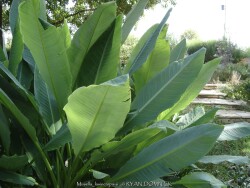

This magnificent ornamental banana relative is more of a shrub than the typical banana "tree". The lower trunk is more swollen and grey-green leaves are more stiff and wind tolerant. Heights of about 3-5' with equal spread are typical in Kansas. This plant is grown more for its flowers but this rarely occurs in our colder climate: beautiful tropical foliage and growth form make up for it though! In Eastern Kansas, typically our 40 inches of rainfall is sufficient without extra water in good soils. This species will tolerate some degree of drought but fastest growth will occur in rich well-drained soils with extra water and fertilizer provided during the summer. Great for summer wet areas in full sun or around swimming pools (creates no messes). It will not tolerate excessively wet soils during dormancy. Chinese Yellow Banana will slowly divide and send up offsets close to the main trunk; this is a desirable sign that it is establishing well. Sunburning can happen with summer temperatures over 105 degrees F but it will quickly outgrow the damage. These bananas need at least 1/2 day of full sun and protection from excessive winds to properly grow. In our trial gardens in Lawrence, KS (zone 6a), a well established specimen has thrived for 5 years and counting. During the arctic blast of February, 2021, lows down to -17 degrees F on Feb 16th, 2021 were recorded. The longevity of this cold blast was also impressive: 10 days on a row with highs of 10-15 degrees F or lower, 8 nights of lows in the single digits and negatives, and 36 straight hours of 0 degrees F and mostly lower. A hard ground freeze was inevitable.
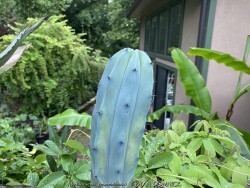

Blue Candle Cacti (Myrtillocactus geometrizans ) are known for its brilliant powder blue skin. If you touch it however, the powdery silver color permanently rubs off leaving a green skin underneath. Native to tropical deciduous forests in Mexico, it's usually grown as a patio or house plant in Kansas. In the wild, established blue candle cacti are hardy to 25 degrees F for short periods of time. Grow in full sun with occasional extra watering including that which comes from rainfall. Repotting may or may not be needed depending on how large you want the plant to grow; plants can continue to grow taller and tolerate extremely root-bound pots but may need wind bracing. If repotting, make sure to use a sharp draining medium organic cactus mix with plenty of sand and perlite. To play is safe, potted plants are best moved in before night temperatures get below 45 degrees F. It is important to avoid the combination of wet and cold. Before extreme cold occurs, move to a bright interior window over the winter with no watering and keep above freezing. As a winter house plant, it will look presentable all winter long with just no waterings. As a permanent house plant, provide bright light and allow the soil to dry between waterings for many years of carefree enjoyment. Plants grown permanently indoors may begin to elongate stretching for light and lose their spine color. It can be hard to reproduce the intense UV sunlight they need so moving outside for the summer is best. Generally if moving outside for the summer, allow 1-2 weeks of part shade or morning sun before placing in full sun. Plants with time to acclimate will thrive in full sun but be careful not to rush it or sunburning will occur. Potted plants are very low maintenance. I have never seen any insect problems on this plant.
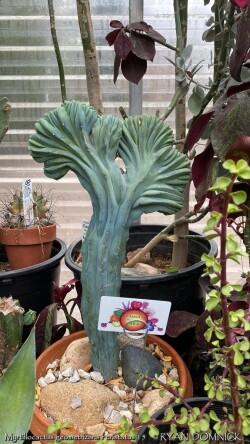

Dinosaur Back Cactus (Myrtillocactus geometrizans f. cristatus) are known for its brilliant powder blue skin on stems that crest and create waves as it grows. If you touch it however, the powdery silver color permanently rubs off leaving a green skin underneath. Native to tropical deciduous forests in Mexico, it's usually grown as a patio or house plant in Kansas. In the wild, established plants are hardy to 25 degrees F for short periods of time. Grow in full sun with occasional extra watering including that which comes from rainfall. Repotting may or may not be needed depending on how large you want the plant to grow; plants can continue to grow taller and tolerate extremely root-bound pots but may need wind bracing. If repotting, make sure to use a sharp draining medium organic cactus mix with plenty of sand and perlite. To play is safe, potted plants are best moved in before night temperatures get below 45 degrees F. It is important to avoid the combination of wet and cold. Before extreme cold occurs, move to a bright interior window over the winter with no watering and keep above freezing. As a winter house plant, it will look presentable all winter long with just no waterings. As a permanent house plant, provide bright light and allow the soil to dry between waterings for many years of carefree enjoyment. Plants grown permanently indoors may begin to elongate stretching for light and lose their spine color. It can be hard to reproduce the intense UV sunlight they need so moving outside for the summer is best. Generally if moving outside for the summer, allow 1-2 weeks of part shade or morning sun before placing in full sun. Plants with time to acclimate will thrive in full sun but be careful not to rush it or sunburning will occur. Potted plants are very low maintenance. I have never seen any insect problems on this plant. Dino is rare and will command a higher price than most other houseplants.